组织行为学精要第十版chapter4 job attitudes
- 格式:ppt
- 大小:1.67 MB
- 文档页数:19
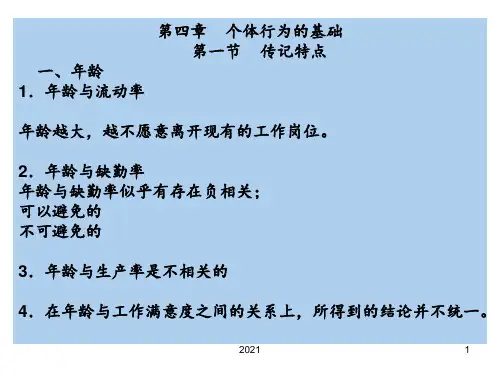
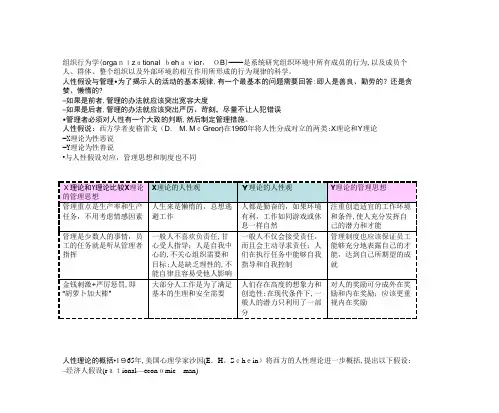
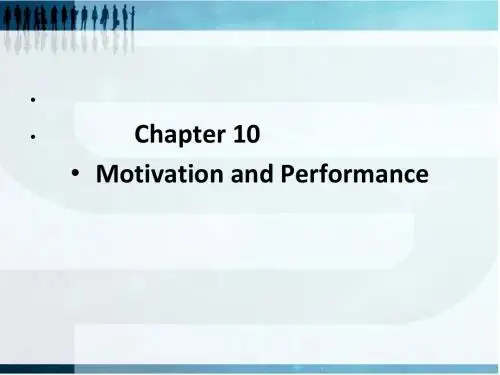
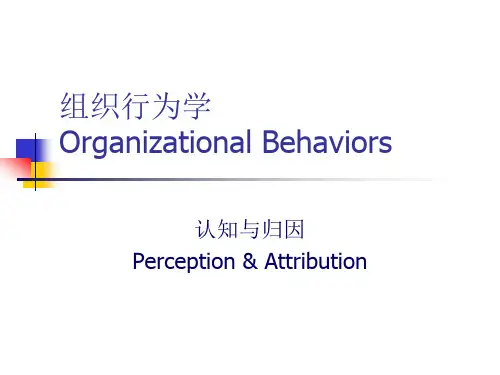

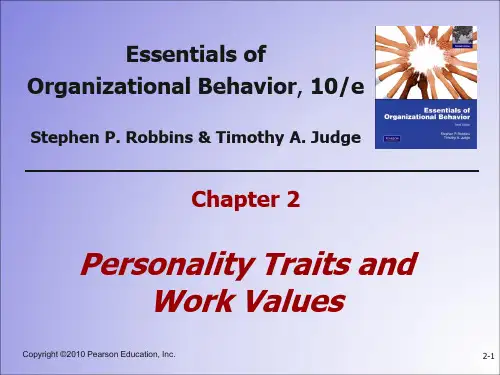
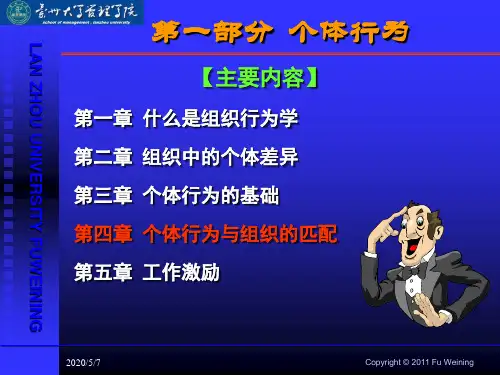
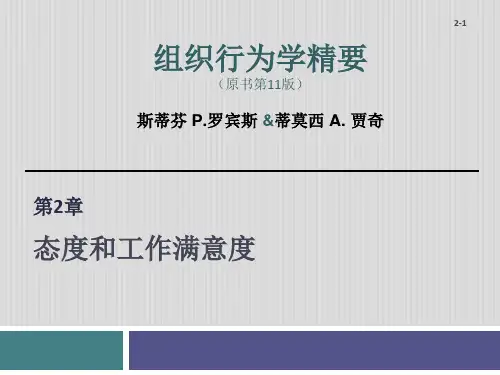

组织行为学第4次任务第4次任务社会调查报告:(20分)选择一个你比较熟悉的企事业单位,对它的主要领导者进行一次访问,请围绕如何成为一名成功的管理者,写出一个600字至1000字的调查报告。
要求说明以下内容:1、该企事业单位的名称、住址、主要经营活动或工作内容;2、该企事业单位领导班子的现状及问题;3、重点分析该单位的领导班子素质和工作作风?4、你的收获是什么?怎样才能成为一名成功的管理者?注:上述报告可以通过各种途径收集资料,你可以查阅有关文献,咨询一些专家,也可以到网上搜索一些资料来左证你的观点。
要求注明资料来源。
凡资料详实、来源清楚的至少可以得及格分;凡资料不实,来源不清的为不及格。
1、该企事业单位的名称、住址、主要经营活动或工作内容;答:顶新国际集团(Ting Hsin International Group)集团总部位于位于台湾台北市,顶新的前身是1958年创立于台湾彰化的鼎新油厂,由彰化永靖出身的魏应州、魏应交、魏应充、魏应行四兄弟共同创立。
1988年10月开始投资大陆,凭"诚信、务实、创新"的经营理念,和顶新人的艰苦努力,经过10年的发展,顶新集团目前在大陆投资总额达12亿美元,旗下共拥有55家营运公司、34家工厂、3家量贩店、31家速食餐厅,员工近24000人。
顶新国际集团方便食品事业部分,已相继在天津、广州、杭州、武汉、重庆、西安、成都、沈阳等地设立生产基地,在全国形成了一个区域化的生产、销售格局,年产方便面近50亿包,是国内最大的方便面生产企业。
集团亦涉足糕饼、饮品、粮油、快餐连锁、大型量贩店、朝日啤酒、百事等多个事业领域,产品种类已发展到百余种,并已有“康师傅”纯净水、利乐包饮料、八宝粥、“3+2”夹心饼干等在国内同类产品中名列前茅。
“康师傅”品牌已成为消费者心目中方便美食的代名词。
顶新在不断自我壮大的同时亦不忘回馈社会。
积极配合国家“希望工程”投入1千万元兴建了19所希望(中)小学;还与宋庆龄基金会合作,创立了“顶新专项基金”,资助海峡两岸妇女、儿童的交流活动及中国少年儿童福利事业。
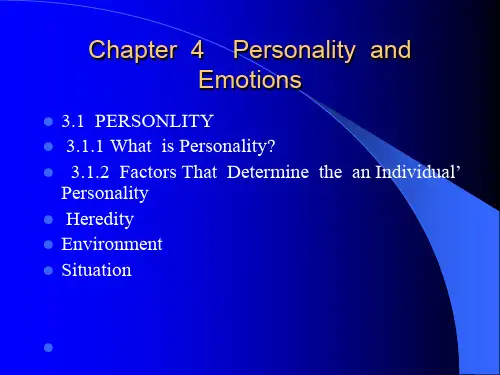
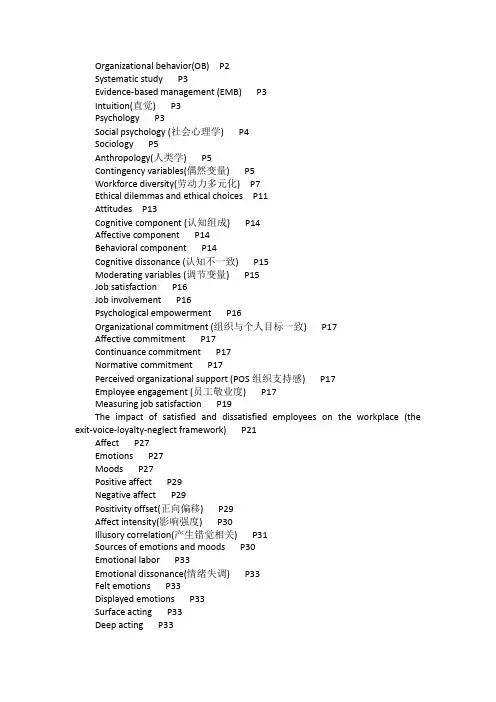
Organizational behavior(OB) P2Systematic study P3Evidence-based management (EMB) P3Intuition(直觉) P3Psychology P3Social psychology (社会心理学) P4Sociology P5Anthropology(人类学) P5Contingency variables(偶然变量) P5Workforce diversity(劳动力多元化) P7Ethical dilemmas and ethical choices P11Attitudes P13Cognitive component (认知组成) P14Affective component P14Behavioral component P14Cognitive dissonance (认知不一致) P15Moderating variables (调节变量) P15Job satisfaction P16Job involvement P16Psychological empowerment P16Organizational commitment (组织与个人目标一致) P17Affective commitment P17Continuance commitment P17Normative commitment P17Perceived organizational support (POS组织支持感) P17Employee engagement (员工敬业度) P17Measuring job satisfaction P19The impact of satisfied and dissatisfied employees on the workplace (the exit-voice-loyalty-neglect framework) P21Affect P27Emotions P27Moods P27Positive affect P29Negative affect P29Positivity offset(正向偏移) P29Affect intensity(影响强度) P30Illusory correlation(产生错觉相关) P31Sources of emotions and moods P30Emotional labor P33Emotional dissonance(情绪失调) P33Felt emotions P33Displayed emotions P33Surface acting P33Deep acting P33Emotional intelligence(EI) P34OB applications of emotions and moods P35Personality P41Heredity(遗传) P42Personality traits P43Myers-Briggs type indicator (MBIT) [extraverted vs introverted ; sensing vs intuitive; thinking vs feeling ; judging vs perceiving] P43Big five model[extra-version外向; agreeableness亲和; conscientiousness认真负责的; emotional stability ; openness to experience ] P44Core self-evaluations P46Machiavellianism(权术主义) P47Narcissism (自恋型) P47Self-monitoring P48Risk taking P48Type a personality P48Proactive personality(主动性人格) P49Values P50Terminal values P50Instrumental values P50Personality-job fit theory P51Power distance P53Individualism(个人主义) P53Collectivism(集体主义) P53Masculinity(男权主义) P53Femininity(女权主义) P54Uncertainty avoidance P54Long-term orientation P54Short-term orientation P54Perception P57Attribution theory(归因理论) [distinctiveness 独特的; consensus 一致性; consistency 连贯性] P58Fundamental attribution error P59Self-serving bias P60Common shortcuts in judging others P60Selective perception P60Halo effect(光圈影响) P60Contrast effect(对比影响) P60Stereotyping P60Rational decision-making model P62Bounded rationality(有限理性) P62Intuitive decision making P63Common biases and errors in decision making P63Organizational constraints on decision making P66Creativity P67Three-component model of creativity P68Motivation P72Hierarchy of needs[physiological ;safety; social; esteem; self-actualization] P73 Theory X and theory Y P74Two-factor theory P74Hygiene factors(卫生因素) P75McClelland’s theory of needs[need for achievement(nAch); need for power(nPow); need for affiliation(nAFF)] P76Self-determination theory P77Cognitive evaluation theory P77Self-concordance(自我和谐) P78Goal-setting theory P78Management by objectives(MBO) P80Self-efficacy theory(自我效能) P81Pygmalion effect P82Equity theory P84Distributive justice(个体判断) P84organized justice P84Procedural justice(程序判断) P85Interactional justice(相互作用判断) P86Expectancy theory[relationship: effort - performance; performance - reward; rewards - personal goals] P86Job characteristics model(JCM) P90Job design P90Job rotation(岗位轮换) P92Job enrichment(工作丰富化) P93Flextime(弹性工作时间制) P94Job sharing P96Telecommuting P96Participative management(参与管理) P98Representative participation P98How to pay: rewarding individual employees through variable-pay programs P100Variable-pay program P100Flexible benefits P103Group P106Formal group P106Informal group P106Command group P107Task group P107Interest group P107Friendship groups P107Five- stage group-development model[forming; storming stage; norming stage; performing adjourning stage] P108Group property P109Role perception P109Role expectations P109Norms P110Reference group P111Deviant workplace behavior(不正常的工作场所行为) P112 Status P113Social loafing(社会性懈怠) P115Cohesiveness P115Group decision making P116Group-think P117Group-shift P117Brainstorming P119Nominal group technique P119Work group P123Work team P123Problem-solving team P124Self-managed work teams P124Cross-functional teams P124Virtual teams P125What factors determine whether teams are successful? P126 Multi-team systems P127Organizational demography(组织的人口统计学) P129 Team processes P130Communication process P135Formal channels P136Informal channels P136Direction of communication P136Interpersonal communication(人与人之间的交际) P137 Formal small-group networks P140Grapevine (秘密信息来源) P140Electronic communications P142Barriers to effective communication P145Filtering P145Communication apprehension P147High-context cultures P148Low-context cultures P148Leadership P150Trait theories of leadership P151Behavioral theories of leadership P152Initiating structure P152Consideration P152Employee-oriented leader P153Fiedler contingency model P154Least preferred co-worker (LPC)[leader-member relations; task structure; position power] P154Leader-member exchange(LMX) theory P156Charismatic leadership theory P157Transactional leaders (相互作用的领导关系) P160Full range of leadership model P161Authentic leaders P163Socialized charismatic leadership P164Trust P164What are the consequence of trust? P165Attribution theory of leadership P165Substitutes for P166Neutralizers P166Identification-based trust P167Chapter1 Introduction to Organizational BehaviorChapter2 Job AttitudesChapter3 Moods, Emotions, and Organizational BehaviorChapter4 Personality Traits and Work ValuesChapter5 Individual Perception and Decision-MakingChapter6 Motivation 1: Basic ConceptsChapter7 Motivation 2: Applied ConceptsChapter8 GroupsChapter9 TeamsChapter10 Communication ProcessChapter11 Leadership。
《组织行为学精要》简介
《组织行为学精要》简介
《组织行为学精要》从个体、群体和组织系统三个层面探讨组织中人的工作行为,阐述人的'内在心理和外在行为之间的关系。
《组织行为学精要》简介是小编为大家整理的,在这里跟大家分享一下。
《组织行为学精要(原书第七版)——MBA教材精品译丛》
作者:(美)斯蒂芬·P·罗宾斯
出版社:机械工业出版社 2003年4月
ISBN:7111117131
定价:39元
部分目录
第一部分绪论
第1章组织行为学简介
第二部分组织中的个体
第2章个体行为基础
第3章人格与情绪
第4章基本激励概念
第5章激励:从概念到应用
第6章个体决策
第三部分组织中的群体
第7章群体行为基础
第8章理解工作团队
第9章沟通
第10章领导与创造信任
第11章权力与政治
第12章冲突与谈判
第四部分
第13章组织结构基础。
组织行为学形考第四次任务如何成为一名成功的管理者在未来竞争激烈的社会里,对成功的管理者的素质要求愈来愈高。
未来的成功的管理者既不是单纯的技术专家,也不只是精通领导艺术的专家。
他们不仅要胜任旧有成效的管理工作,还要有力地领导自己的团队在同心协力完成既定目标的同时,时刻准备迎接新的挑战。
未来成功的管理者应具备的十种关键素质是:1.战地指挥家。
越来越多的实践表明:企业需要的是能控制局面的领军人物——能够像装甲坦克一般用低沉的语调镇住整个会议室、不论有多大困难和障碍都能达到目的的人。
做生意就像是打仗,而作为职业经理,最好是战地指挥家。
2.胸怀坦荡。
不斤斤计较个人得失,能谅人之短,补人之过。
善于倾听不同的意见,集思广益。
善用一种对员工包容和关怀的管理方式。
对集体取得的业绩看得比个人的荣誉和地位更重要。
3.团队组建、信念的传播能力。
未来的企业更需要团队组建者和信念的传播者——即能够与雇员建立良好关系,向员工灌输企业忠诚理念的人。
4.感染力和凝聚力。
能用言传身教或已有的业绩,在领导层和员工中不断增加感染力、凝聚力的人。
这种人在组织决策中,把信任不是建立在地位所带来的权威之上,而是靠自身的感染力来影响大家,坚定人们的信念。
5.“做大梦”的能力。
能够对领导班子成员提出的众多议题,提出自己新颖的思想、建设性的意见或建议,把握好前进的方向,不断培养自己带领大家超越现实、想得更远。
6.同情心。
在组织工作中,不能只靠行政命令去强制人们的意志,而要努力去了解别人,并学会尊重别人的感情。
选择人们普遍接受和认可的方式,让一颗博大的仁爱之心赢得众人的支持。
7.预知能力。
技术和全球化要求人们在工作中拥有新技巧、新能力和新的做事方式,以应对市场的瞬息万变。
这就需要成功的管理者有创新精神和战略预知能力。
8.医治能力。
对于一个成功的管理者来说,当企业出现经济变革和重大变故时,能像一位成熟的外科手术主治医师那样,及时医治自己的企业是非常了不起的。
第1章什么是组织行为学1.l 复习笔记一、管理者做什么管理者通过别人来完成工作,他们做出决策、分配资源、指导别人的活动从而实现工作目标。
1. 管理者的职能20世纪初,法国工业家亨利·法约尔(Henri Fayol)提出,所有的管理者都发挥五种职能:计划、组织、指挥、协调和控制。
今天这些职能简化为四种:计划、组织、领导和控制。
(1)计划计划活动就是要设定或明确组织的目标,制定实现组织目标的途径或方案。
(2)组织为了实现计划活动所预定的目标,实施计划活动制定的行动方案。
(3)领导管理者就运用各种适当的方法,去影响组织的成员,努力营造起一种使组织中的成员能够全心全意、士气高昂地为实现组织目标而努力奋斗的氛围,以便使管理的领导职能得到更大的发挥。
(4)控制为了确保组织目标的顺利实现,组织的管理者从头到尾地对组织各项活动的进展情况进行检查,一旦发现或预见问题后就要及时采取措施予以纠正,以保证组织活动按计划进行。
2. 管理者的角色20世纪60年代末,麻省理工学院(MIT)的研究生亨利·明茨伯格对5位高层经理进行了一项精心研究,明茨伯格得出结论:管理者扮演着10种不同的但又互相关联的角色。
这10种角色可以归纳为三大类:人际角色、信息传递者角色以及决策角色。
(1)人际关系方面的角色人际关系角色指所有的管理者都要履行礼仪性和象征性角色。
(2)信息传递方面的角色信息角色是指所有的管理者在某种程度上,都从外部的组织或机构接受和收集信息。
(3)决策制定方面的角色在决策角色中,管理者处理信息并得出结论。
亨利·明茨伯格界定的10种管理角色如表1.1所示。
3. 管理者的技能罗伯特·卡茨(Robert Katz)提出了三种基本的管理技能:技术技能、人际技能和概念技能。
(1)技术技能技术技能,指为了完成或理解一个组织的特定工作所必需的技能,也就是业务方面的技能。
(2)人际技能人际技能,指与组织单位中上下左右的人打交道的能力。
Organizational Behavior:systematic study of the actions and attitudes that people exhibit within organizations.组织行为学研究的内容:1.Productivity2.Absenteeism3.Turnoveranizational citizenship5.Job SatisfactionContributing DisciplinesPsychology、Sociology、Social psychology、Anthropology 、Political scienceGoals of Organizational Behavior:Explain、predict,、controlLevels of OB Analysis:1.Individual Level2.Group Levelanization System LevelChapter 2Values:Represent basic conviction that "a specific mode of conduct or end-state of existence is personally or socially preferable to an opposite or converse mode of conduct or end-state of existence."Rokeach Value Survey 1.Terminal values 2.. Instrumental valuesHofstede’s Framework for Assessing Cultures1.Power distance2.Individualism vs. collectivism3.Achievement vs. nurturing4.Uncertainty avoidance5.Long-term vs. short-term orientationAttitudes1.Evaluative statements—either favorable or unfavorable—concerning objects, people, or events2.Reflect how one feels about somethingJob satisfaction:refers to a collection of feelings that an individual holds toward his or her job Cognitive dissonance occurs when there are inconsistencies between a person’s attitudes or between a person’s behavior and attitudesPerception is a process by which individuals organize and interpret their sensory impressions in order to give meaning to their environmentFactors Influencing Perception1. perceiver2. object or target being perceived3 context of the situation in which the perception is madeAttribution Theory:When we observe an individual’s behavior, we attempt to determine whether it was internally or externally caused.Attribution Theory 1.Distinctiveness 2.Consensus 3.ConsistencyFundamentalattribution error - tendency to underestimate the influence of external factors and overestimate the influence of internal or personal factorsSelf-serving bias- tendency for individuals to attribute their own successes to internal factors such as ability or effort while putting the blame for failure on external factors such as luckShortcuts to Judging Others1.Selectivity 2. Assumed Similarity 3. Stereotyping 4. Halo EffectPersonalityThe combination of psychological traits we use to classify & describe a person in terms of characteristics such as quiet, passive, loud, aggressive, etc.The Big-Five Model1.Extroversion2.Agreeableness3.Conscientiousness4.Emotional Stability5.Openess to ExperienceLocus of control - Belief that life is controlled by oneself vs. outsidersMatching Personalities and JobsSix-personality-types model - an emplo yee’s satisfaction with and propensity to leave his or her job depend on the degree to which the individual’s personality matches his or her occupational environmentWhat are Emotions?1. Affect– covers a broad range of feelings that people experience2.Emotions– intense feelings directed at someone or something3.Moods– feelings that tend to be less intense, lack a contextual stimulusEmotional LaborEmployee expresses organizationally desired emotions during interpersonal transactionsFelt emotions are an individual's actual emotionsDisplayed emotions are those that are organizationally-required and considered appropriate in a given job Emotional Intelligence1 .Self-Awareness 2. Self-management 3. Self-motivation4. Empathy 5 .Social SkillsMotivation :The willingness to do something, conditioned by this a ction’s ability to satisfy some need for the individual.Need - a physiological or psychological deficiency that makes certain outcomes appear attractive Maslow’s Hierarchy of Needs Theory1.Physiological2.Safety3.Social4.Esteem5.Self-ActualizationTheory X Workers 1.Dislike work 2.Must be threatened with punishment 3.Avoid responsibilities 4.Seek formal direction 5.Require security 6.Little ambition Herzberg ’s Two-Factor TheoryMcClelland's Theory of Needs1.Need for achievement (nAch) - drive to excel2.Need for power (nPow) - the need to make others behave in a way they would not have behaved otherwise 3Need for affiliation (nAff) - the desire for friendly and close interpersonal relationshipsHigh achievers1.High achievers prefer jobs with personal responsibility, feedback, and intermediate degree of risk.2.High achievers are not necessarily good managers.3.Affiliation and power closely related to managerial success4.Employees can be trained to stimulate their achievement need.Goal-Setting Theory1.Specific goals lead to increased performance.2. Difficult goals, when accepted, result in higher output than easy goals.Equity Theory1.Employees weigh what they put into a job situation (input ) against what they get from it (outcome ).2.Then they compare their input-outcome ratio with the input-outcome ratio of relevant others.。